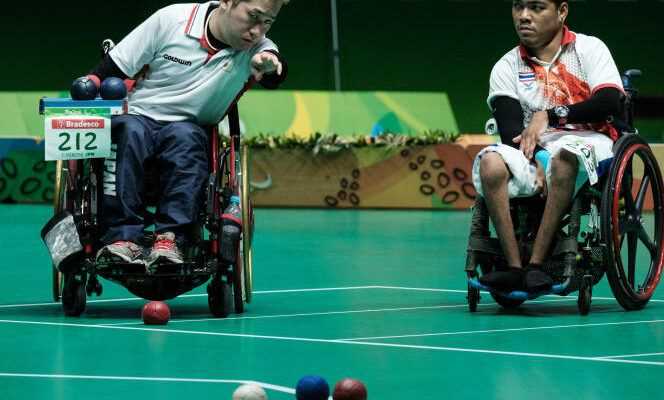If the Paralympic Games are often less publicized and followed than the Olympic Games, they allow the discovery of different sports, adapted to different types of disabilities. This will be the case again for the Tokyo Paralympic Games, which will be held from August 24 to September 5.
Boccia, goalball, sitting volleyball, or even wheelchair rugby… These sports mean nothing to you? We will explain everything to you.
The boccia, ” ball “ in Italian, is one of two Paralympic sports that do not have Olympic equivalents. By its principle and its rules, this event can be compared to pétanque. It has been included in the Paralympic Games since 1984. Initially, only wheelchair players with persistent muscle tone disorders could compete. From now on, the boccia is intended for anyone in a wheelchair presenting a severe limitation of their motor functions.
Boccia is played on an indoor court measuring 12.5 mx 6 m, the dimensions of a badminton court. The game begins with the throwing of a white ball, called a “jack”, which has the same role as the jack in pétanque. The players then alternately throw their six balls and must bring them as close as possible to the white ball. A team has blue balls; another, reds. At the end of each round, the team whose ball is closest to the jack scores a point, and may receive an additional point for each ball that is closer to white than the nearest opposing balls. Depending on the category and handicap, players can throw the balls using their hand or using a launching pad.
The individual and doubles matches are played over four rounds, while the team events are over six ends. Since its appearance at the Paralympic Games, the discipline has been dominated by South Korea, which has won no less than nine gold medals, against eight for Portugal and six for Brazil.
It is the other sport, with boccia, which only exists at the Paralympic Games and has no equivalent among able-bodied. Goalball is reserved for the visually impaired, visually impaired or blind. Originally developed for the rehabilitation of soldiers wounded during World War II, the sport was entered in the Paralympic Games in 1980 for men and in 1984 for women.
A goalball match sees two teams of three players (with three substitutes) oppose each other on an 18m x 9m court, the size of a volleyball court. Everyone must wear a mask in order to level the participants and to protect their eyes. The goal is to score by rolling the ball by hand towards the opposing goal, which spans the entire width of the pitch, while the opponents try to block the ball with their bodies. For a pitch to be legal, the ball must rebound in specific places. A bad throw is sanctioned by a penalty, and the player who misses his shot must defend his goal alone.
The ball is made of rubber and has bells inside for players to hear. The public is also asked to keep quiet. At the end of the two periods of twelve minutes each, the team which has scored the most goals wins.
Wheelchair rugby
While wheelchair basketball is fairly widespread and well-known, this is less the case with its rugby counterpart. These matches have the particularity of being played on basketball courts… with a volleyball.
The matches take place in four periods of eight minutes each, and the winner is the one who scores the most points. For this, a team, made up of four players on the field, must carry the ball behind the opposing goal line, the two wheels of the chair having to touch or exceed this line. But we have to go fast. A team has only forty seconds to score a try from taking possession of the ball. And players have to dribble or pass the ball at least every ten seconds, which makes it an intense sport. Passes can be made in any direction. And contact between chairs is allowed, but not contact between players.
Each player is assigned a point value based on his handicap: from 0.5, for players with the lowest physical function, to 3.5, for those with the highest function. While a group is made up of twelve players, the total value for each team of four players on the field cannot exceed eight points. This system allows minor handicaps to oppose more serious handicaps without creating too much imbalance between the teams. As for the record, Australia became the first country to win gold at the Paralympic Games twice in a row. Will she make the pass of three this year?
Like goalball, sitting volleyball was created in the aftermath of World War II to aid in the rehabilitation of injured soldiers. This sport was entered in the Paralympic Games in 1980 for men, and in 2004 for women.
A match is played six against six in the best of five sets. To win a round, you have to reach 25 points, and 15 in the fifth round, with two points difference. While the rules are much the same as for valid volleyball, the court is smaller and the net lower. On the other hand, in sitting volleyball, it is possible to counter the service, which is not the case in valid volleyball. To move, players must slide without leaving their seated position, and they are required to maintain contact with the ground.
Our selection of articles on the Tokyo 2021 Paralympic Games
Find all our content on the Tokyo Paralympic Games, from August 24 to September 5:
